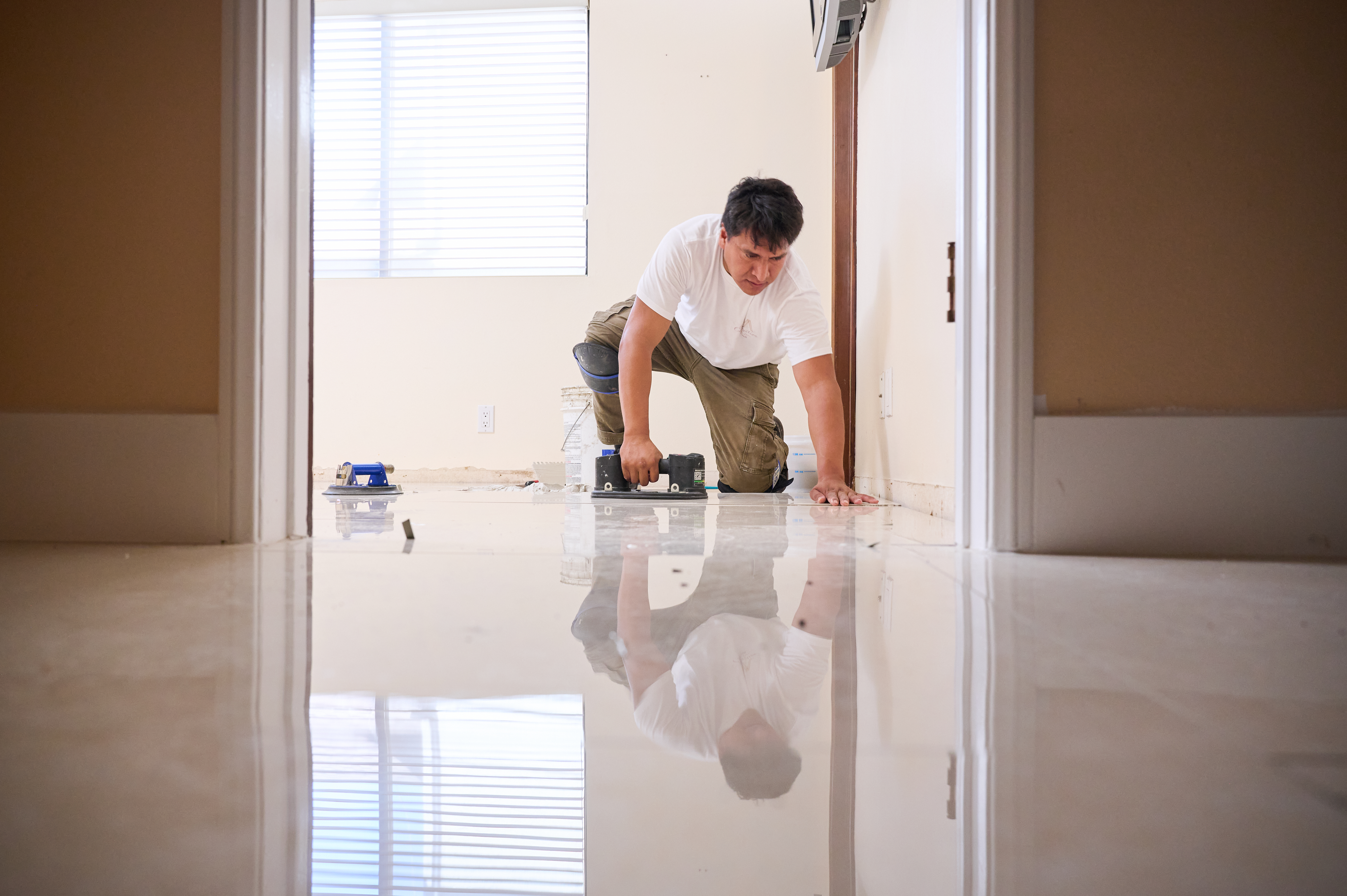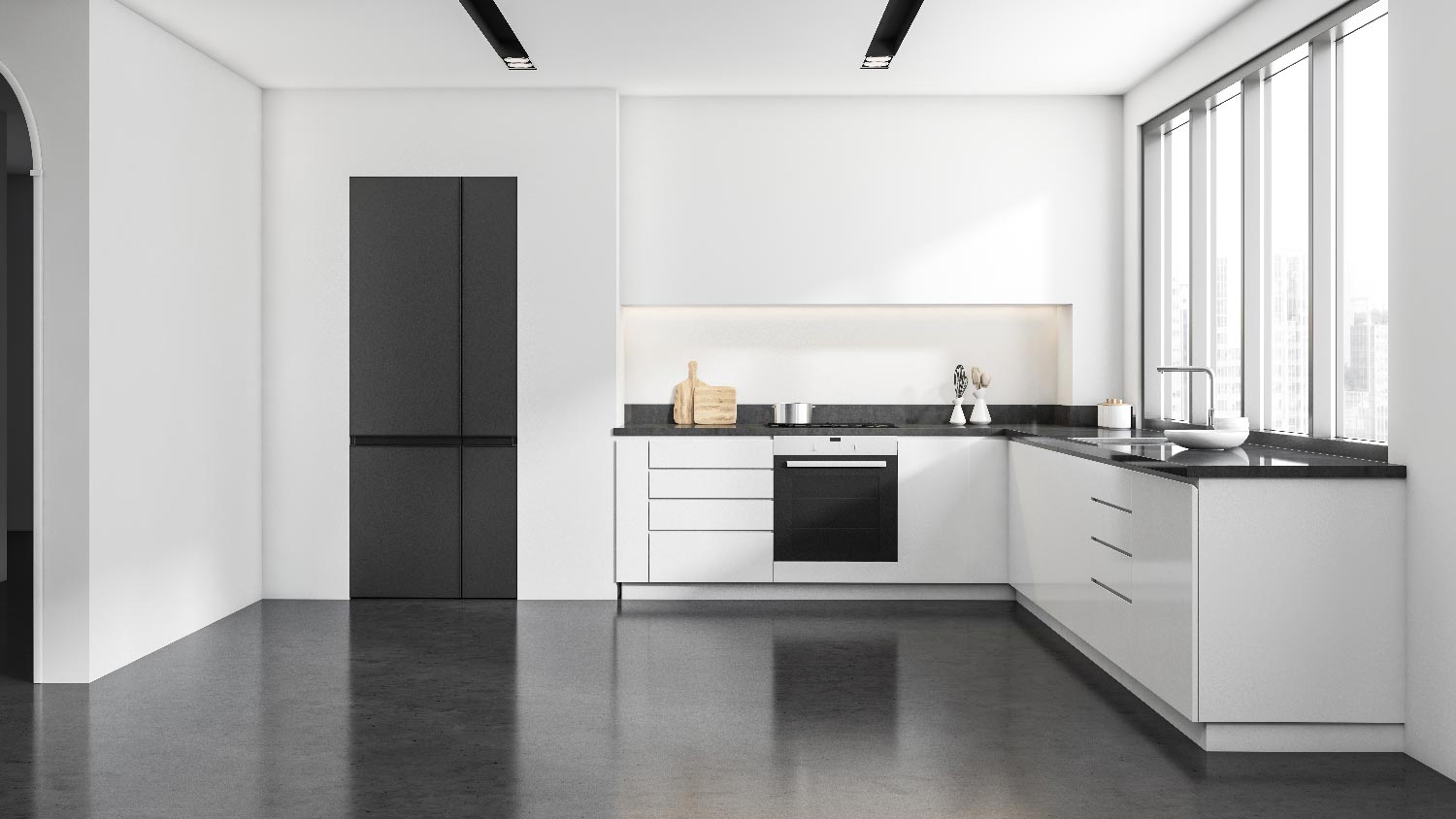
Laminate is a solid choice for many homes because it's durable and budget-friendly. Check out this guide to learn about laminate flooring installation costs.
This weekend project can transform the look of an oil-stained garage floor


If you’re sick of staring at pesky oil and grease stains on your garage floor, it may be time for a fresh coat of paint. Paint is actually about more than aesthetics—it’s a great way to protect your garage floor from dirt, debris, mold, mildew, and the automobile fluids responsible for the hardest-to-clean stains. All it takes is a little know-how, since you’ll need the paint to adhere correctly. This guide will show you how to paint a garage floor in a few simple steps, whether you’re using basic latex paint or planning for a DIY epoxy floor.
There are a few different types of paint that hold up on garage floors. Latex paints and epoxy paints are both popular. Latex cleans up easily with soap and water, making it best for beginner DIYers. For oil-based paints or two-part epoxies, you’ll need to use a solvent to clean up any accidental splatter. Either way, make sure you choose paint specifically made for concrete garage flooring.
Keep in mind that two-part epoxy involves a more extensive application process than latex paint or one-part epoxy, but it will seal your concrete garage floor with a moisture-resistant and stain-resistant finish. Most paints also require a primer, so make sure you look at the directions on the package.
Before you start painting a garage floor, always check the weather. Your paint should have temperature suggestions in the instructions. Both low-surface temperature and high humidity can hurt the durability of your paint job—so make sure you get it right the first time.
It’s important to thoroughly clean your garage floor before painting. This way, you won’t accidentally seal in any dirt or grime. In particular, paint won’t adhere as well to oil and grease stains.
Clean loose debris using a broom and wet-dry vacuum. If you have any grease stains, apply a degreaser and scrub with a stiff-bristled brush. Avoid metal bristles as they could scratch the concrete. For stains that won’t budge, you can use a pressure washer. Make sure you let the floor dry completely before you start painting.
Paint adheres better to a textured surface, so if your garage floor is shiny and smooth, you’re going to need to rough it up a bit. You can use either muriatic acid or an etching solution. The final texture should be similar to a fine-grit sandpaper.
Keep in mind that muriatic acid is a corrosive chemical and you should proceed with extreme caution. You’ll need to wear gloves, full-coverage protective clothing, goggles, and a respirator. Apply per the manufacturer’s instructions.
If you don’t want to use corrosive chemicals, you can use a power grinder or sander to gently rough up the floor. In this case, use your wet-dry vacuum to clean up the dust when you’re done.
Before applying primer, inspect your garage floor for cracks and chips. You can make minor repairs using a concrete patching compound and following the instructions on the package. Make sure you smooth out the patch before it dries so the surface is level with the rest of your floor. If you need to repair large cracks or significant damage, it’s best to hire a concrete contractor near you.

Painting can get messy, so you’ll need to prep your space to prevent accidental spills and splatters. Move out any furniture or storage containers. You want your floor as clear as possible. Use a drop cloth or plastic sheeting to cover walls and workspaces, and apply painter’s tape around the edges of your floor.
You can find out how much paint or primer to use by measuring the square footage of your garage. One gallon typically covers around 400 square feet. Make sure your primer works with the type of paint you’re using on your garage floor (it should say in the manufacturer’s instructions, but it’s often labeled garage floor or concrete primer).
Since contents tend to separate, stir the primer until it’s evenly mixed. Pour the primer into the paint pan.
The best way to paint a garage floor is to start around the edge using a technique called “cutting in.” Use a paintbrush to paint a border of primer along your floor where it meets the wall. This border should be 2- to 3-inches thick.
Once you’ve painted the edges, you can switch to a roller and paint the rest of your floor. Screw an extension rod into the back of your roller, so you can do the job while standing. Start in one corner (applying directly over the border) and continue to the rest of the floor. Continue outward until the floor is evenly coated—but make sure not to back yourself into a corner.
Once you’re finished, let the primer dry per the manufacturer’s instructions before moving to the next step.
Make sure your paint is specifically designed to coat concrete or masonry—there are many products branded specifically for garage floor painting. Those will adhere the best.
Pigment tends to separate as paint cans sit. When you open the can, you’ll need to mix the paint with a paint stirrer until the color is evenly distributed. Pour the paint into a paint tray to get started with your first coat.

For this step, you’ll use the same “cutting in” method as you used to apply the primer. Use a paintbrush to make a 2- to 3-inch border of paint around the edge of your floor where it meets the wall.
Some prefer to do the entire first coat using a paintbrush, which helps work the paint into the rough concrete surface. Otherwise, you can use a roller to apply paint evenly across your entire floor (without backing yourself into a corner). Start in a corner, painting over the border you previously painted, and continue to the rest of the floor. Make sure each strip of paint slightly overlaps the last so there are no gaps.
Allow your first coat of paint to dry before you apply a second.
Once your first coat of paint is dry, you can apply a second coat using the same method. You may want to apply this coat perpendicular to the first coat to prevent streaking. The second coat will take longer to try than the first coat.
It’s important to let the paint fully dry before walking or driving a car on your garage floor. Refer to the manufacturer’s instructions. Most latex-based garage floor paint dries in a few hours, but you should wait at least 24 hours before walking on the freshly-painted surface. Give it a week before you pull your car into the garage.
If you paint your garage floor DIY, you can save a fair chunk of change. Most concrete floor paints cost $15 to $30 per gallon, and you’ll need two gallons to cover the average one-car garage with two coats (plus a gallon of primer). In contrast, if you hire a pro, interior painting usually costs $2 to $6 per square foot, while garage epoxy flooring costs an average of $2,500.
That said, painting a garage floor is a tedious process—and if you don’t do it right, the paint won’t adhere. While it doesn’t require a ton of work hours, you have to spread this project out over the course of a few days as you wait for paint to dry at various stages. If you don’t want to deal with the hassle, it’s better to hire a garage floor coating contractor near you.
If you’d like to save some money, you can prep your garage for painting by power washing the area and fixing minor cracks or divots. Once your garage floor is ready to paint, you can bring in the pros. Always make sure you get at least three quotes, so you can find the best deal.
From average costs to expert advice, get all the answers you need to get your job done.

Laminate is a solid choice for many homes because it's durable and budget-friendly. Check out this guide to learn about laminate flooring installation costs.

If your laminate is damaged, it’s time for repairs or replacement. This guide will show you everything you need to know about laminate floor repair costs.

Discover natural stone flooring costs for your home. Learn about material, labor, and installation factors to budget confidently for your flooring project.

Unleash the beauty of your space by learning how to stain hardwood floors. Whether old or new, perfectly stained floors can add character and class to a room.

Updated flooring can make any room in your home feel brand new. Explore flooring installation costs in Minneapolis, MN, from materials to labor costs.

Uneven floor joists don’t just lead to annoyingly sagging floors; they could be a sign of bigger issues. Here’s who to hire to fix flooring joists.